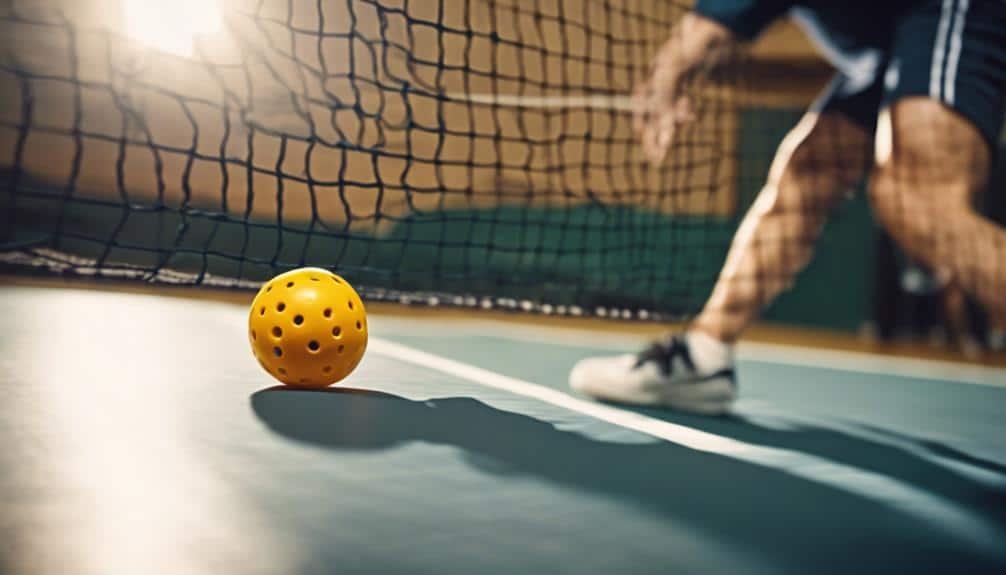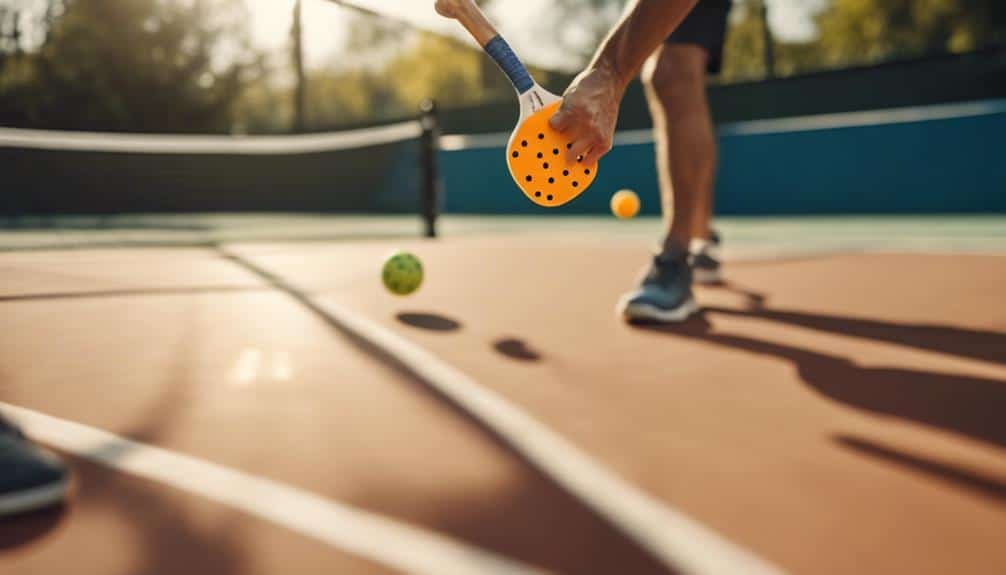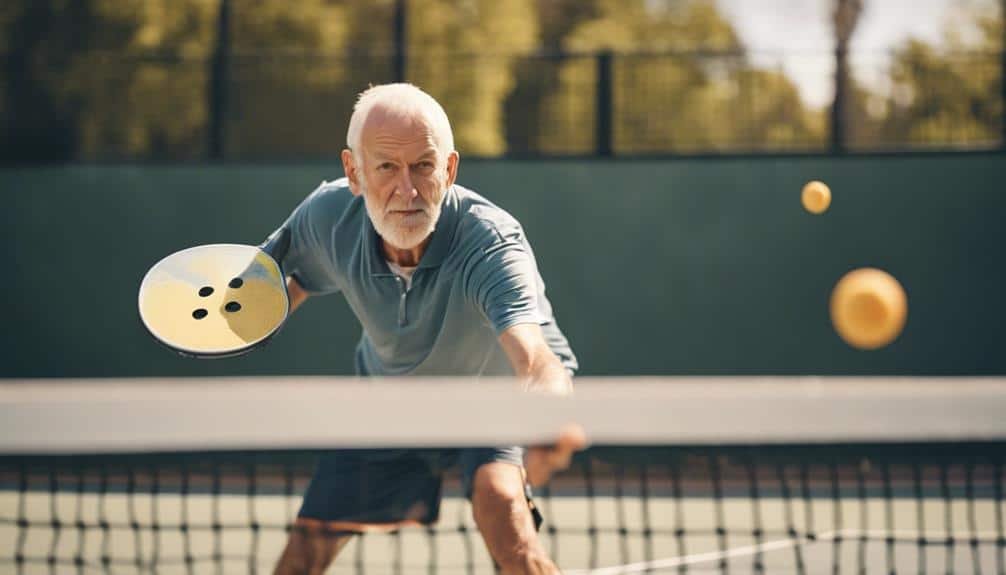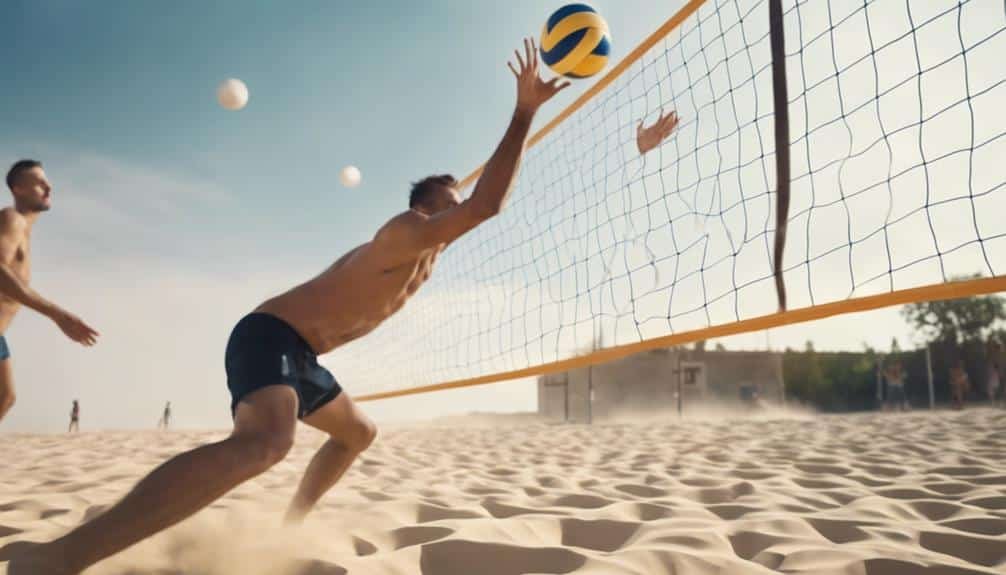I've uncovered the secrets of the volley dink, a game-changing shot in pickleball that combines quick reflexes with a soft touch. To master this technique, I focus on proper form: keeping my paddle up, using a soft grip, and stepping into the shot. I practice with cones placed on the non-volley zone line to improve accuracy and control. Common mistakes I avoid include hitting too hard and neglecting consistent practice. The key is executing with precision and developing touch to keep opponents off-balance. By incorporating volley dink drills into my routine, I've significantly elevated my game. There's more to explore about this crucial shot.
Key Takeaways
- Use a soft grip and short, controlled motion to tap the ball gently over the net.
- Keep your paddle up and ready, stepping forward to meet the ball early.
- Practice hitting targets (like cones) to improve accuracy and control in protecting the ball.
- Combine quick reflexes with a soft touch, focusing on precision rather than power.
- Consistently practice volley dinks to develop muscle memory and improve overall performance.
Understanding the Volley Dink

A volley dink is a crucial shot in pickleball that combines the quick reflexes of a volley with the soft touch of a dink.
As a 5.0 rated Senior Pro and IPTPA-certified Master Teaching Professional, I've seen firsthand how mastering this shot can elevate your game.
The volley dink offers numerous pickleball benefits, including improved control, accuracy, and the ability to keep your opponents off-balance.
In my experience since 2016, I've found that many players struggle with this shot.
That's why I've developed a drill to help you perfect your volley dink.
By setting up cones on the court and practicing hitting them, you'll enhance your precision and learn to protect the ball from going too deep.
This straightforward routine is suitable for players of all levels and can be practiced regularly for consistent improvement.
Setting Up the Drill
To set up the volley dink drill, you'll need a pickleball court, several cones, and a partner or ball machine.
I recommend placing the cones strategically on the non-volley zone line, creating targets for your volley dinks. Space them evenly, about 2-3 feet apart, to challenge your accuracy.
This drill offers numerous pickleball benefits, including improved control, precision, and consistency in your volley dinks.
As you progress, try various drill variations to keep it engaging. For instance, alternate between forehand and backhand volleys, or increase the distance between cones for a greater challenge.
Executing the Perfect Volley Dink

Mastering the perfect volley dink requires proper technique and consistent practice.
As a Pickleball Pro, I've found that focusing on volley fundamentals is crucial. Keep your paddle up and ready, maintaining a soft grip.
When the ball approaches, step forward and meet it early, before it drops too low. Use a short, controlled motion to tap the ball gently over the net, aiming for the cones you've set up.
Remember, the key is to protect the ball from going too deep. This drill will help you develop the touch and accuracy needed for effective volley dinks.
Common Mistakes to Avoid
Several common mistakes can hinder your progress when practicing volley dinks.
As a pickleball fundamentals expert, I've observed players struggling with these volley techniques.
To improve your game, avoid these pitfalls:
- Hitting the ball too hard
- Failing to keep your paddle up and ready
- Not stepping into the shot
- Neglecting to watch the ball make contact with your paddle
Mastering Control and Accuracy

Mastering control and accuracy in volley dinks requires focused practice and attention to key techniques.
As a member of the pickleball community, I've found that the volley dink drill introduced earlier is invaluable for honing these skills. By setting up cones and practicing hitting them, I've significantly improved my ability to protect the ball from going too deep.
This drill has become a cornerstone of my volley strategies, allowing me to gain an edge over opponents.
I can't stress enough how crucial it's to incorporate this straightforward routine into your regular practice.
Whether you're a beginner or a seasoned player, consistently working on your volley dinks will yield noticeable improvements. Remember, control and accuracy are paramount in pickleball.
Adapting for Different Skill Levels
The volley dink drill can be effectively adapted for players across all skill levels, from beginners to advanced competitors.
I've found that incorporating skill assessments helps tailor the drill to individual needs. For beginners, I recommend starting with larger cones and slower-paced volleys. As players progress, I gradually decrease cone size and increase volley speed.
Player testimonials consistently highlight the drill's versatility.
Beginners: Focus on basic form and contact
Intermediate: Introduce varied angles and spin
Advanced: Incorporate footwork and quick transitions
Elite: Add pressure situations and decision-making elements
Incorporating Into Your Practice Routine

To maximize the benefits of the volley dink drill, I've developed a structured approach for integrating it into your regular practice sessions.
Start by dedicating 15 minutes to this drill at the beginning of each practice. As you improve, gradually increase the duration and incorporate drill variations. For example, try alternating between forehand and backhand volley dinks or adding a partner to simulate game-like scenarios.
I recommend practicing this drill at least three times a week to see significant improvement in your volley dink skills.
Remember, consistency is key in the pickleball community. By making this drill a regular part of your routine, you'll develop muscle memory and improve your overall game.
Don't hesitate to share your progress with fellow players – it's a great way to stay motivated and connect with others who share your passion for pickleball.
Advanced Volley Dink Techniques
Once you've mastered the basic volley dink drill, I'll introduce advanced techniques to elevate your game.
As a member of the pickleball community, I've discovered effective practice methods for improving volley dinks.
These advanced techniques focus on:
- Varying ball spin and pace
- Adjusting contact point for different angles
- Incorporating footwork to enhance positioning
- Developing deception in your shots
Strategies for Match Play

After honing your advanced volley dink techniques, it's time to apply these skills strategically during match play.
As a seasoned pickleball player, I've found that mastering volley dinks can give you a significant edge on the court.
When implementing your volley dink strategy, focus on placement rather than power. Aim for the opponent's feet or the sidelines to keep them off-balance.
Mix up your shots by varying the pace and spin to keep your opponents guessing.
Remember, patience is key in volley dink exchanges. Wait for the right opportunity to attack, and don't rush your shots.
Use your improved control to set up winning opportunities for your partner.
By incorporating these volley tips into your match play, you'll become a more formidable player and a valuable teammate.
Practice these strategies consistently, and you'll see your game elevate to new heights.
Tracking Your Progress
Throughout your volley dink practice, it's crucial to track your progress systematically.
As you embark on your pickleball journey, monitoring your volley benefits will help you stay motivated and identify areas for improvement.
I recommend keeping a detailed log of your practice sessions, noting:
- Number of successful volley dinks
- Accuracy in hitting targets
- Time spent practicing
- Areas of difficulty or improvement
Conclusion
I've unveiled the secrets of the volley dink, a game-changing technique in pickleball.
By implementing this drill and focusing on control and accuracy, you'll see your skills soar like a well-placed shot.
Remember to avoid common pitfalls, incorporate advanced techniques, and track your progress.
With consistent practice, you'll master the volley dink and elevate your match play.
Now, it's time to step onto the court and put these secrets into action.

